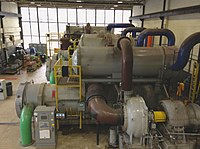
Photo from wikipedia
Abstract The prime mover size for a Combined Cooling Heating and Power (CCHP) system is determined through the adoption of different strategies in load following, which are based on a… Click to show full abstract
Abstract The prime mover size for a Combined Cooling Heating and Power (CCHP) system is determined through the adoption of different strategies in load following, which are based on a fraction of demands. Multi-objective optimization is employed for finding the optimal design in each case by considering annual average efficiency (AEF), payback period (PBP), and annual carbon dioxide emission (ACE) as the objectives. Then, a comprehensive comparative study is conducted to compare the objective functions and monthly values of different performance criteria with each other. Comparisons are made among results of optimization for different scenarios, and the ones obtained from the base case condition (building without a CCHP system), as well as following electrical and thermal demands conditions. Along with these comparisons, the sensitivity analyses are done to determine the impact of variation of each demand on the optimum results individually. The results indicate that following an optimum fraction of electrical demand is the best strategy for all the investigated load ratios. In the reference load ratio, it has 14.3% and 4.6% better AEF and ACE than the base case. Moreover, for the reference load ratio, the initial purchase price and operating cost are 33.8% and 12.2% lower, leading to a PBP of 1.687 years. According to the sensitivity analyses, it is also found that the highest level of variation in the optimum fractions comes from changes in the cooling load.
Journal Title: Journal of Cleaner Production
Year Published: 2021
Link to full text (if available)
Share on Social Media: Sign Up to like & get
recommendations!